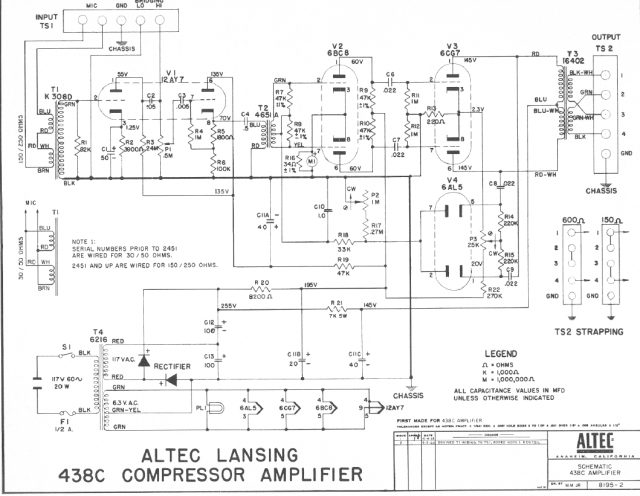dustbro said:
Thanks for the advice and safety warning! I'm definitely the kind of guy who starts poking around HV without thinking first...
So I started poking around and found that the point where R16 and R6 go to ground was broken, so I repaired that and it seemed to fix an issues I had with my noisy input pot ;D
How does one check the "cathode to grid" voltage?
With referece to ground, I have the following voltages on V3
1 - 108v
2 - 0v
3 - 2.2v
6 -108
7 - 0v
8 - 2.2v
with my multimeter leads between pins 2 and 3 I get 2V and with my leads between pins 7 and 8 I get -2V.
Well you either measure it directly with a multimeter, or you measure all pins to ground and do a subtraction. You've done both which is fine.
Just check once again the sign of the measurements you quoted for the direct measurement of pins 2-3. Pin 2 should be more negative than pin 3. Pin 7 should be more negative than pin 8. I think it's OK based on the other measurements, but you said you got +2V between 2 and 3 and not -2V.
Hmmm.
For the two halves of V3 6cg7 you have:
anode/plate 1 - 108v
grid 2 - 0v
cathode 3 - 2.2v
anode/plate 6 -108
grid 7 - 0v
cathode 8 - 2.2v
anode voltage definitely looks too low compared to the schematic.
Cathode voltage looks good (relative to the low anode voltage).
Grid looks good (0v)
So you have 2.2V/220R = 10mA of total bias current, which is spot on.
The overall anode current can also be measured as 180 (V@R21) - 108 (V other side R21) /7K = 72/7K =10mA
Glad to see it matches the cathode current = no shorts or leaks to anywhere else.
But an additional 10mA through V3 should not cause such a huge drop from 255V (load excluding V3) to 180V (load including V3) out of your power supply at the junction of R12 C20 IMHO. That's 75V drop for 10mA load, or a power supply with an internal resistance of 7K5 which is way too odd.
Another easy test to confirm or exclude this suspicion raised by your previous comments about this voltage drop when v3 is inserted or not:
Can you turn the compressor on with V1 and V2 inserted but not V3 inserted and measure the voltage at the junction of R20 and C12 relative to the chassis?
Tip: suggest connecting up your multimeter before turning on the power so you don't have to move anything inside the box whilst the power is on.
The initial peak no load voltage could be as high as (117 * 2 * 1.414) = ~ 330V. Once things settle down it will be lower than this.
Remember that no significant current will flow until the tubes/valves heat up, so you're probably gonna have to wait 30 seconds or more before you measure stable voltages.
Check if the voltage at the junction of R20 and C12 stabilizes at 255V with V1 & V2 inserted but not V3 (as you previously wrote)
Turn off. Be patient and don't burn your fingers on hot tubes. Go and have a cup of tea in the meantime

Then repeat with V1 V2 V3 inserted and see if it really does reduce to 180V (again as you previously wrote)
If so that would really turn the spotlight on the voltage doubler and PSU.
Based on that I would suspect the voltage doubler then (the 2 diodes and the 2 capacitors in the Delon circuit C12 C13 http://en.wikipedia.org/wiki/Voltage_doubler) as well as C110. You say you've replaced the diodes, so I'd look at the two power caps (safely discharge them first via say a 22K resistor across the terminals without touching any terminal with your hand) You could also check that when powered up that the voltage at the junction of C12/C13 is (almost) exactly half the voltage at the junction of C12/R20. If it isn't, then the cap with the significantly lower voltage drop may have gone leaky. A 100uF 400V power cap is only going to cost less than $10 to replace if that's the issue and you don't mind using a non-vintage replacement.
Now if you need to measure the balancing: There's no real way to do this easily on this compressor. You can either place your multimeter in series with one winding of the output transformer and the anode in current measurement mode in turn to measure the current directly. Or you can insert 100 ohm resistors in series between the anode of each half of the valve and the corresponding tap of output transformer (pin 1 to red & pin 6 to red/white) and measure the voltage on either side of these resistors to ground. With 10mA of total current you'll only drop maximum one volt across this resistor even if it is 100% unbalanced.... Current in each leg = (V anode - V output transformer)/100). They should match for proper operation. Normally this occurs pretty naturally due to the natural negative feedback within the valves themselves, but it could still be faulty/ non matched valves.
So I'd concentrate on the power supply side first as it's an easier test, and you've already tried 3 different valves.



































